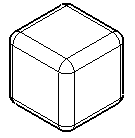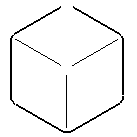Generation Tab | ||
| ||

Dress-up
- Hidden Lines
- Select this check box to generate hidden lines.
- Center Line
- Select this check box to generate the center line.
- 3D Colors
- Select this check box to generate the colors of a part.
Note: If you clear Disable generative view style usage in Tools tab, then this option will not be available.
- Pattern
- Select this check box to generate patterns.
- Axis
- Select this check box to generate axis lines.
- Thread
- Select this check box to generate threads.
Important: You can generate threads in exact views pointing parts that were created using the Paste Special > As Result with Link command. To sum up, technological results enable you to generate the same threads (and thread dimensions) from an original part as from its "as result with link" copy. Here is what you need to know about this functionality: - CPU and memory consumption are decreased while creating or updating a view containing such threads.
- This functionality is not available for views generated using the CGR, Approximate and Raster generation modes.
- Once you have created technological results for a given part, it is recommended not to deactivate them. If you do so anyway, some thread dimensions may become not-up-to-date (and will be displayed using the color defined in tab if the Activate Elements' Analysis is active) .
- Thread dimensions created with the Thread Dimension command are not generated from 3D constraints (and they are displayed using the black color). Therefore, you will not be able to drive 3D constraints from such dimensions.
- In Part Design, you can delete one or more elements contained in a Technological Results node (in order to restrict the information you provide). When a Technological Results node is available in a 3D Part representation, the Drafting view is computed with it, disregarding the geometry dimensions. Then, elements missing in the node are not projected in the Drafting view.
- Fillets
-
Select this check box to generate fillets, then select the type of fillets to generate.
Note: If you are a DS Passport customer, you can read the QA00000005018 article from the Knowledge Base for additional information.
- Boundaries
-
Select this option to generate fillets as thin lines, representing the mathematical limits of the fillets.

Important: Boundaries will not be projected if they correspond to two faces which are continuous in curvature. They will be projected only if they correspond to a smooth edge which is situated between two faces whose curvature radii vary. This mode will be used automatically to represent a connection between two faces which are not joined by a fillet, no matter what option you select. - Symbolic
- Select this option to generate fillets as original edges, projected in a direction that is normal to each corresponding surface.

- Approximated Original Edges
- Select this option to generate fillets as original edges, at the intersection of the two surfaces joined by the fillet.

- Projected Original Edges
- Select this option to generate fillets as original edges, projected on fillet surfaces in the direction of the view
projection.

This option also allows you to avoid projecting fillets which overlap with the actual geometry edges, thus enabling you to create associative dimensions on views. However, this is applicable only for those fillets which have two supporting faces, out of which at least one of the faces is planar.
Notes:
- This projection mode is equivalent to the CATIA V4 fillet projection mode.
- If you are a DS Passport customer, you can read the QA00000007533 article from the Knowledge Base for additional information.
Important: The following information applies to Symbolic, Approximated Original Edges and Projected Original Edges: - Only those fillets for which fillet faces exist in the corresponding 3D will be shown.
- Dimensions on fillets are not associative for Symbolic and Approximated Original Edges.
- Dimensions on fillets with two supporting faces including at least one planar face are associative for Projected Original Edges.
- Such fillets cannot inherit 3D colors. Likewise, when using generative view styles, such fillets cannot inherit the 3DInheritance view dress-up parameters (defined in file, ).
- Always bear in mind that those fillets representations are only a symbolical preview of the 3D.
- 3D points
-
Select this check-box to projects points from 3D (no construction elements), then select the type of 3D points to generate.
- 3D symbol inheritance
- Select this option if you want to keep the symbols that are used in the 3D representation to project 3D points.
- Symbol
- Select this option if you want to use a new symbol to project 3D points, and select the symbol of your choice from the drop-down list.
- 3D wireframe
- Select this check box to visualize both the wireframe and the
geometry on generated views.
You can choose whether projected 3D wireframe can be hidden or is
always visible:
- Can be hidden
- Select this option if you want 3D wireframe geometry to follow the standard removal of hidden lines.
- Is always visible
- Select this option if you want 3D wireframe geometry to always be visible. In this case, it will follow the standard removal of hidden lines.
Important: In the case of wireframes being coincident behind a part boundary, they may be seen as relimited lines when 3D Wireframe and Can be hidden are selected.
![]()
3D extracted representations
Indicates which 3D representations are projected in the view. You cannot modify this property.
Note: To modify the setting that defines which 3D representations are projected in views, go to View.
- All design representations
- The view was created from all design representations.
- First design representations
- The view was created from only the first level of
design representations. In the example below, the first design
representations are surrounded in blue.

- As session
- The view was created from all 3D representations in session.
![]()
Generation Mode
- Only generate 3D shapes larger than
- Select this check box to specify that you only want to generate 3D shapes which are larger than a certain size, and indicate the appropriate size by providing a value in millimeters in the appropriate field.
- Enable occlusion culling
- Select this check box to save memory when generating exact views from an assembly (or a part or product) which is loaded in Visualization mode (i.e. when the Work with the cache system option is active). This will load only the parts which will be seen in the resulting view (instead of loading all of them, which is the case by default), which optimizes memory consumption and CPU usage.
- View generation mode
- Select an option to change how the view is generated. A short description of
the various view generation modes is provided below. For a detailed
description (including the advantages and restrictions pertaining
to each mode), refer to View Creation > About the View
Generation Modes. To a lesser extent, you may also refer to
View.
- Exact view
- Select this option to turn the view into an exact view (the geometry becomes available).
- CGR
- Select this option to turn the view into a CGR view (only the external appearance of the component is used and displayed; the geometry is not available).
- Approximate
- Select this option to turn the view into an approximate view. Although approximate views are not as high in precision and quality as exact views, this generation mode dramatically reduces memory consumption. Performances may also be improved, depending on how you fine-tune precision (click the Options button). Therefore, the approximate mode is particularly well-adapted to sophisticated products or assemblies involving large amounts of data.
- Raster
- Select this option to turn the view into an image view. You can configure a number of
options such as the level of detail or the type of image to
generate (shading, shading with edges, etc).
Important: To use the raster generation mode, the Angle option must be set to 0 in the Orientation and Scale section of the View tab.
Notes:
- If you selected a mix of exact, CGR, approximate and/or raster views before launching the Properties dialog box, the options will be disabled. To activate these options, make sure you select views which use the same generation mode.
- Dress-up properties are specific to each view generation mode. These properties are thus not taken into account when you change the view generation mode. Reverting to the first view generation mode lets you recover the dress-up properties.
![]()
Generative view style
| Important: These properties are only available on generative views, when generative view style functionality are activated (i.e. when the Disable generative view style usage option is cleared in Administration). |
- Generative view style
The Generative view style area shows the generative view style which is applied to a single view or multiple selected views. In case of multiple selected views, display of generative view style is dependent on the following cases:
- Case 1: If one of the views is not generated using generative view style, while the other is, then the Generative view style area is unavailable.
- Case 2: If both the views are generated using different generative view styles, then no generative view style is displayed in the list or it will be blank. However, you can select a desired generative view style from the list and apply to both the views simultaneously.
- Case 3: If both the views are generated using the same generative view style, then it shows the generative view style which is applied to the views. However, you can select a different generative view style available from the list and apply to both the views simultaneously.
- Reset to style values
- If you have modified the values of the properties defined in the selected generative view style (for example if you have modified dress-up properties), click this button to reset these values to the original style values. (To let you know when properties have been changed compared to the original generative style, an asterisk is displayed in front of them).
- Remove style
- Click this button to remove the generative view style. Notice that when you click this button, all options on the tab are disabled.